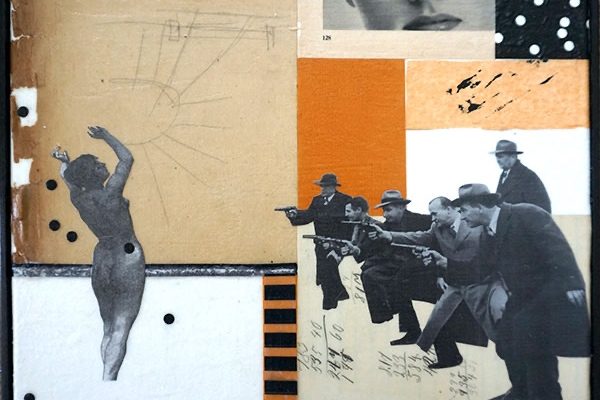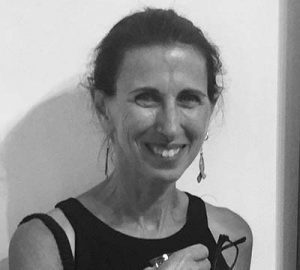 Kim Triedman is a practicing visual artist and an award-winning poet and novelist living in Arlington, MA. She works primarily in collage and mixed media and often uses her own photography in her pieces. Much of her work focuses on issues of gender expectations, historical perceptions of femininity and sexuality, and the weight and challenge of changing expectations. Triedman’s pieces have been shown widely in small and large group shows throughout the northeastern United States and earned her numerous juror’s awards and mentions. In 2018, she curated and participated in the show “Waste Not,” which was featured as the cover story in ArtScope Magazine. Her work can be found at her website and in numerous private collections here and abroad. She is a graduate of Brown University. Her work appears in WTP Vol. IX #4.
Kim Triedman is a practicing visual artist and an award-winning poet and novelist living in Arlington, MA. She works primarily in collage and mixed media and often uses her own photography in her pieces. Much of her work focuses on issues of gender expectations, historical perceptions of femininity and sexuality, and the weight and challenge of changing expectations. Triedman’s pieces have been shown widely in small and large group shows throughout the northeastern United States and earned her numerous juror’s awards and mentions. In 2018, she curated and participated in the show “Waste Not,” which was featured as the cover story in ArtScope Magazine. Her work can be found at her website and in numerous private collections here and abroad. She is a graduate of Brown University. Her work appears in WTP Vol. IX #4.
Interview with Kim Triedman
By Jennifer Nelson, WTP Feature Writer
Nelson: Please describe the techniques and materials you use to create the collage on canvas “Misogyny,” and is it intended finally, as a kind of commentary on the masculine and feminine roles in today’s society?
Triedman: My technique is always evolving. These days, I do tend to use a lot of layering, a lot of transparent or semitransparent papers, and of course a lot of photography—either my own or vintage black and whites and often digitally manipulated. I also use a ton of vintage papers—receipts, old ledgers, envelopes, architectural plans, etc. I often start by blocking out a canvas or wood board with interesting papers that somehow speak to one another and then building up from there.
As to the second part of your question: On the level of the individual piece, I never really know what it’s about for me until it’s complete. It’s like there’s some subterranean thing going on, and only when I finish a piece do I realize why I needed to make it in the first place.
This was definitely true for this piece. I was first drawn to the woman on the left, which is the image I began with. I was struck by the softness of the female form, how it seems to almost float in the air, and how the curve of her body represents a kind of freedom, and the beauty of that freedom, but also, from a different perspective, a kind of chaos. The chaos of curve, as I like to think about it: something ungovernable; uncontrollable; something beyond what is acceptable.
So then, of course, you have the men to the right representing this different perspective, the need to rein in the chaos—their guns, the harshness of their angles, the darkness of their amassed form, even the mathematical equations scribbled in the background: the need to control, to pin down. The call to order.
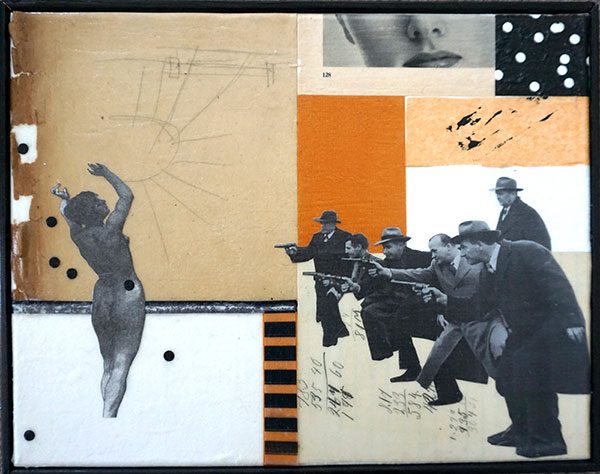
Nelson: Before becoming a collage artist, you were a published poet and novelist. What events prompted you to switch from writing to the visual arts, and how has your literary background informed your artwork?
Triedman: So, yes…I was a writer first. I began working in collage five years ago because I was unable to write for the first time in years. In 2013, I’d published two poetry collections and a novel. It had been an enormously creative time for me, and afterwards I found myself totally blocked. I was extremely frustrated and unhappy. I tried working on another novel, but I found I was being too careful, traversing old ground, doing too much self-editing. I needed to find my voice again—obliquely, through something totally different.
My process—in writing as in art—is very organic. I begin with an image, or a color, or—most often—a combination of two things which call out to one another in an interesting way. In fact, artmaking is very much like writing poetry for me: something grabs me and I follow it down some path until it comes to its resting place at the very end. And it is only then that I knew why I had to create it in the first place. Like an answer to a problem, I never knew I was asking.
The thing about both poetry and collage-making is that they’re both about flying leaps: Images (or words) “choose” each other…patterns repeat, intentionally or not…narratives are suggested as much by what is left out as what is included. From the start, I’ve found it incredibly interesting to see how two distinct images—placed in proximity—can create a totally new and unexpected energy. Sometimes, the combination alone is enough. Sometimes, the narrative that’s suggested is enhanced by repetition and variation and other artistic techniques. What is clear is that the resonance created by unique pairings can be so much larger than the sum of the individual parts. It’s this energy that I seek to harness in my collages.
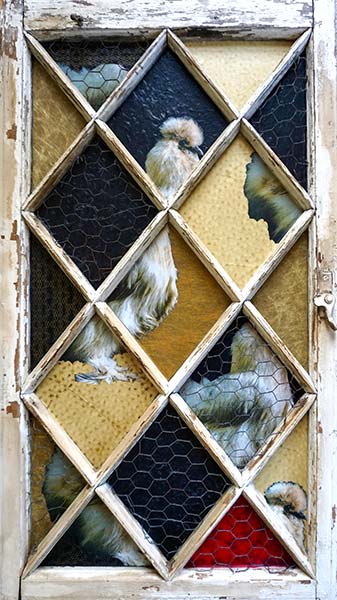
Nelson: How have your mother and daughter, who are both artists, perhaps helped you along in this transition?
Triedman: As a visual artist, I’m entirely self-taught, although my mom is a trained and practicing artist. I’ve always been a “maker,” though. I’ve always loved fashioning things out of other things and I’m very good at figuring out how to do what I want to do. My memories of childhood are filled with such exploits. To the extent that my mom’s example was there from the start, I’m sure that I absorbed something of the meaning and importance of creative work. As an adult, I am lucky enough to have an ongoing dialogue with her about what we are working on and thinking about in terms of our art. My youngest daughter is a RISD-trained artist as well, and so the three of us are all connected by this great artistic thing we have in common.
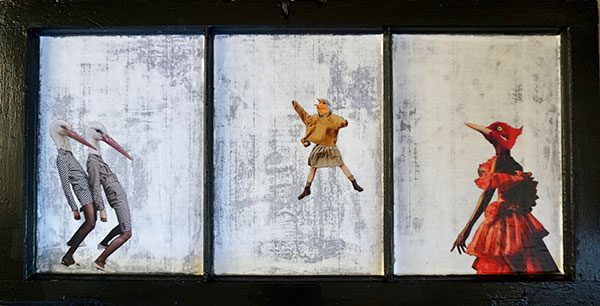
Nelson: Some of your collages are playful, such as “Girls Just Wanna Have Fun” and “Ascendant”, while others weighty, such as “The Lord, She Will Carry Us” and “The Heretics.” What inspired you in each of these collages? Did you start with a particular idea in mind?
Triedman: As I said before, pieces become what they need to become. There’s very little intention. I have no doubt that I was in a very different place emotionally when I made those two particular pieces.
That said, I do generally have a sense of where they came from once they’re done. “Girls Just Wanna Have Fun” simply reflected an end-of-winter need for release—just a play on seasonal claustrophobia, I suppose. “The Lord She Will Carry Us” and “The Heretics” are much more tied to my upbringing, which was kind of bifurcated in a couple significant ways. I grew up in the 60s and 70s, so I’ve always felt I was born into one world and “weaned” in another. My parents were very much products of the 50s—my mother’s family strict Catholics, my father’s non-practicing Jews. So, there was always a kind of tension between the dogmatic and the ungovernable, I guess. A lot of my art reflects this kind of emotional whiplash. There’s a lot of Christian imagery, but also a kind of anarchic quality. It can be wildly associative, often brutally so.
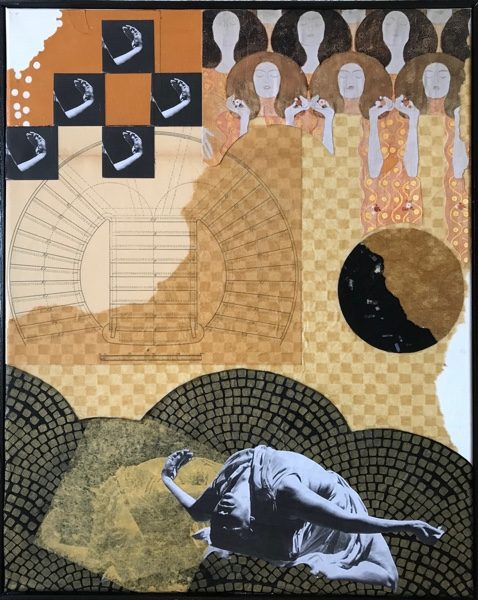
Nelson: Where do you find your images, photographs, and historical documents used in your collages, and do you find some of your materials in your hometown of Arlington, MA?
Triedman: As to source material, I find it everywhere, and every day I find a new favorite! I love historical documents and images, and I’m a collector of old ephemera. My feeling is that if it can be stuck down to something else it’s fair game. Our house and garage are filled with all sorts of flotsam and jetsam. Yard sales are a good source, and yes, used bookstores, but also sometimes eBay when I’m looking for something very specific. I love perusing other people’s trash!
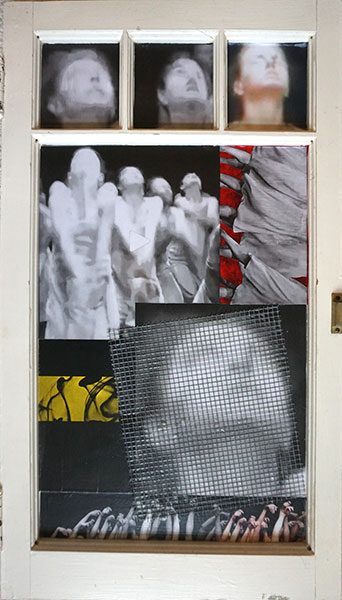
Nelson: When and how did you conceive the idea of using old window frames for your collages? What are the benefits and challenges of applying images on glass?
Triedman: One day, a year or so after my writer’s block set in, I found a beautiful antique window by the side of the road. I brought it home and started collaging directly onto the glass using old papers I’d accumulated over the years. I’ve always loved old things—old papers especially—and much of my work these past several years involves found and recycled objects: old ledgers; receipt and certificates; graphs and architectural plans; newsprint and chicken-wire and laundry line—and, of course, windows, which serve as frame and substrate but also conceptual springboard.
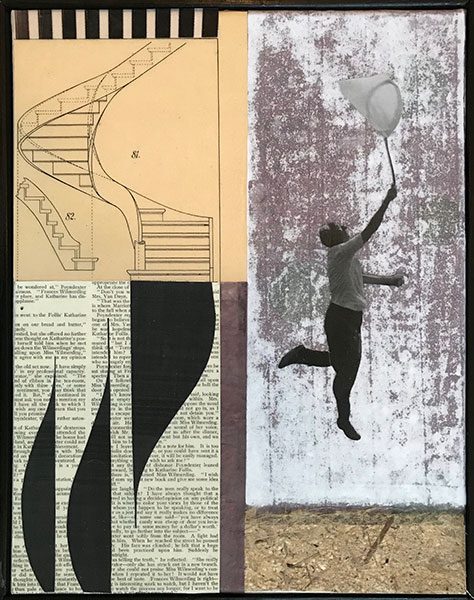
Nelson: How do you see your art evolving in the future?
Triedman: I really can’t keep up with my ideas. Right now, I’m really focused on finding innovative ways to bring my artwork and my poetry together. I really love how creativity can cross discipline lines, and how similar the processes are in the end. I’m experimenting with using poems to inspire art pieces and vice versa, and also incorporating more poetry fragments into the collages. But, I also like the idea of doing some kind of larger project, such as creating a fine art book which incorporates both.
Click here to read more interviews with WTP artists
Copyright 2021 Woven Tale Press LLC. All Rights Reserved

